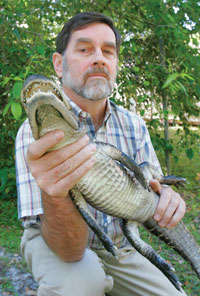|
|
Alligator Farmers Cash In On Fashion Trenddownloadable pdf
While some agricultural producers are facing tough times, Florida alligator farmers are cashing in on reptile chic — the growing worldwide demand for alligator skins on everything from belts and boots to $10,000 designer handbags. “The market for high-end alligator leather products is very strong right now, and farmers are getting top dollar for their gator skins,” said Perran Ross, a wildlife ecologist with UF’s Institute of Food and Agricultural Sciences. “Florida alligator farming has had its ups and downs in recent years, but it’s definitely a good time for those who are already established in the business.” Louisiana is the nation’s leading producer, harvesting about 300,000 alligators every year compared to 60,000 in Florida, but Hurricanes Katrina and Rita damaged alligator egg production in Louisiana. As a result, luxury-goods manufacturers in the United States and Europe need to secure future supplies of alligator skins, which is helping Florida farmers who can provide high-quality products. Allen Register, owner of Gatorama in Palmdale, Fla., one of 60 licensed alligator farms in the state, said prices for alligator bellies range from $40 to $50 per foot, which is up by almost 50 percent from a few years ago. Like other Florida alligator farmers, Register harvests gators when they reach four or five feet in length, which requires about two years of growth. He said Louisiana farmers typically harvest three- or four-foot-long alligators. Christy Plott Redd, marketing director for American Tanning and Leather Company in Griffin, Ga., buys skins from producers all over the world but prefers American alligator skins because of their high quality. “Florida is key to our business because we need those grade-one skins to sell to handbag manufacturers and fashion designers,” she said. Ross, an alligator and crocodile expert in UF’s wildlife ecology and conservation department, said alligator farming has about a $25 million impact on Florida’s economy. He said the vast majority of alligator skins are produced from eggs purchased and collected from wild alligators in the state. Ross said the commercial harvest of alligators actually helps conserve the species and their habitats because the economic incentives from egg production and legal harvesting encourage landowners to maintain wetlands. In addition, license fees from the program help support research, monitoring and wildlife management programs that conserve alligators. “In other words, alligators pay their own way for their conservation,” he said. “Florida has a model program that is emulated all over the world for managing alligators and their habitat for sustainable economic gain.” Alligator farming is also an efficient way to utilize meat and meat products that are not suitable for human consumption. Aged or freezer-burned meat, unused fish from commercial trawlers and offal from poultry processing plants are good sources of food for farms, Ross said. Perran Ross, rossp@wec.ufl.edu Chuck Woods
|

